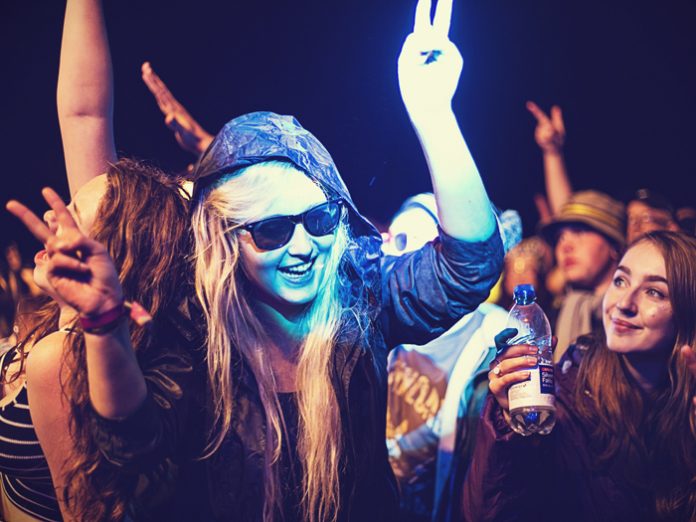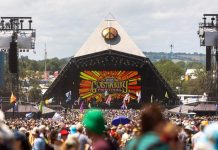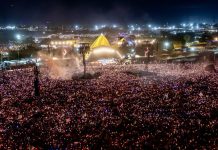Nozstock: The Hidden Valley will celebrate its 20th anniversary from July 20 – 22, with a line-up featuring Chase & Status (DJ), Goldfrapp, Dillinja, The Blockheads, Grandmaster Flash, The Selecter, Dub Pistols and We Are Scientists, to name a few.
Insights recently spoke with Ella Nosworthy, the festival’s Creative Director, about its theme for 2018, approach to sustainability, family friendly atmosphere and more.
Festival Insights: Nozstock will celebrate its 20th anniversary later this year. To what do you attribute the festival’s continued success, and what advice would you give to fledgling festivals looking to achieve longevity?
Ella Nosworthy: There is a special atmosphere at Nozstock that you don’t find at many other events. It’s this special feeling that keeps drawing people back. I think this comes from the fact that it is a family – our family – organising the event and it’s held on the family’s farm so there’s a lot of heart, soul and personal touches that go into everything that you see. The fact that it has grown and evolved from a BBQ on the farm means it has kept that intimate, friendly vibe – like you have been invited by the family to a party for the weekend. Not many festivals are able to offer that.
Nozstock is so much more than music in a field and we are so thankful for the organic way we have been able to grow to retain that same welcoming atmosphere that was present at the earliest editions. That’s probably the advice I would give to new events: don’t grow for the sake of growing. Keep it an organic and natural evolution, add little bits at a time and allow yourself to adjust to what you have before adding more again, so that your audience can grow with you.
FI: The theme for this year’s festival is ‘Nozstalgia’. How can attendees expect to see that concept represented visually throughout the site?
EN: Well, Nozstalgia means different things to different people so there will be lots of different ideas in different areas. A cohesive theme is important but so is having plenty of things to see and discover, so each area is dedicated to a different Nozstalgic idea or concept. Of course there will be different time periods represented – with ‘80s fancy dress, but also old TV programme characters painted onto stage walls. Our decor team are drafting up some great plans, with loads of old gaming characters so that folk will be cast back in time. Also, as it’s our 20th anniversary we will also be celebrating the last 20 years with a museum of Noz, displaying old artefacts and artwork from the early years.
FI: A Greener Festival has commended Nozstock several times for its sustainability efforts in the past. What are the main measures you’re taking to improve in this regard for the future?
EN: Our current focus is on reducing single use plastics at the festival. We’ve joined the Association of Independent Festivals’ ‘Final Straw’ campaign, banning plastic straws from our event and taken the Festival Vision 2025 pledge. We are running a ‘refill, not landfill’ campaign that encourages people to buy re-useable cups and bottles onsite to use throughout the weekend and take home again.
We are also encouraging the use of biodegradable litter, so I think a re-education campaign in these areas is very much our focus for the next few years until we have no single-use plastics onsite. Education through fun is key as well, to really get the audience on board, so we run a clean campsite competition, get one of our stars to plant a tree on Celebritree Avenue, and push lots of lovely green messages out through our hand-painted signs.
FI: Nozstock is renowned for being a great festival for all ages, despite much of its programming leaning towards underground dance music. Has it been challenging to reconcile rave culture with a family-friendly atmosphere?
EN: It can be a challenge, yes, as the two don’t usually go hand in hand and, perhaps, in the beginning we did find the dance music element was a hard sell to families. But the truth is there are plenty of people who appreciate dance music that have families themselves and are really pleased to be able to attend an event which provides music they love, but where also feel comfortable bringing their children. Personally, as a mother myself, I wouldn’t feel comfortable running a festival that offers anything less.
We have lots of support from families now, who when they come realise it isn’t just about dance music. The variety of programming and wealth of stages mean there really is something for everyone to enjoy. I’ve seen some very pleased parents having some really magical times with their children in the daytime; making things, taking part in workshops – who then watch the main headliners with their children before taking them back to the tent to sleep and then, if they are so inclined, taking it in turns to pop out and have a dance to the more underground stuff the kids wouldn’t be into. And why not? Parents still love festivals and their musical tastes don’t change just because they have a family now.
FI: Speaking of the family-friendly atmosphere: how do you go about catering for such a diverse audience in terms of entertainment and activities? Are there any new additions to the wider programme this year that you’re particularly excited about?
EN: Well, our programming team all have very different tastes and opinions, so although during the planning that might lead to some late nights and some frazzled tempers it does mean that naturally the line-up reflects our varied tastes and is a very diverse finished product. We do make sure we are offering different types of music and performances when we are putting the line-up together and that as many genres and arts are represented as time and budget will allow. Nobody just likes one type of performance after all.
For families, specifically we make sure that there is lots of interactive stuff for little ones to really get involved in – lots of make and do rather than just sit and watch. I find that leaves a lot less opportunity for boredom and they get so excited when they have created something really amazing to take home with them. We do offer some quite unusual workshops at the festival as well, such as blacksmithing opportunities and spoon carving. I think something so unusual is always going to be memorable no matter the age. We have a revamped area at the festival this year, which incorporates our theatrics and our craft stages which I’m really looking forward to seeing come to life.
FI: For a number of reasons, recently there has been increasing pressure on festivals to provide more of an effective platform for emerging talent. Are there any ways in which you think festivals can do this in a better way?
EN: There’s a few ways, yes. Lots of festivals have unsigned artist stages and competitions for unsigned bands to play, which is great, but I think establishing links with local media and venues is important, plus student unions and the like, so you are aware of who is being talked about at the time and what raw talent is available near you. I also think promoting those artists is important. Everyone wants to hear about the headline bands but a few social media links to support the smaller artists and get their name out there to your following can make a world of difference and really help to establish your reputation as an event supporting emerging talent.
FI: Is there anything else we should know about Nozstock?
EN: It’s probably the most homemade festival on the scene, and it really is a proper family party, full of extended family and friends. We are lucky enough to own the land the festival takes place on so we are able to build permanent structures which gives us time to make things a little bit more wow. Tight budgets have meant that we have to be creative about how we get these things built, but that also gives the festival a uniqueness and a personality.
We don’t hire a massive crew to come in for two weeks to set everything up. Instead we have a small, dedicated crew who are onsite from around May, putting their sweat and tears into creating the event themselves. What started as a real stumbling block – never having enough money to take our plans into full realisation – has actually become a massive positive I wouldn’t change for the world.





